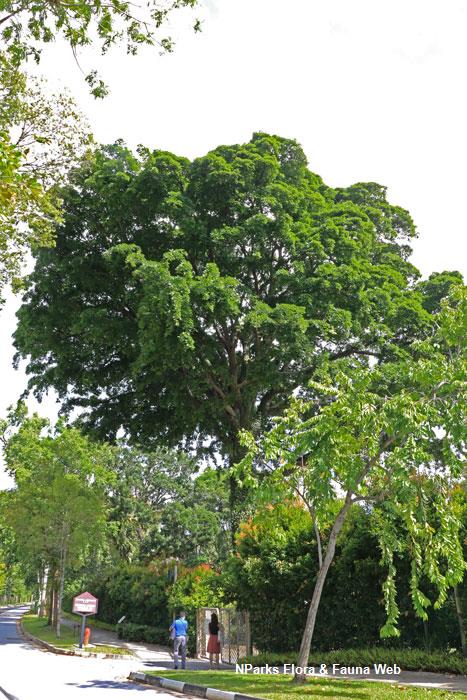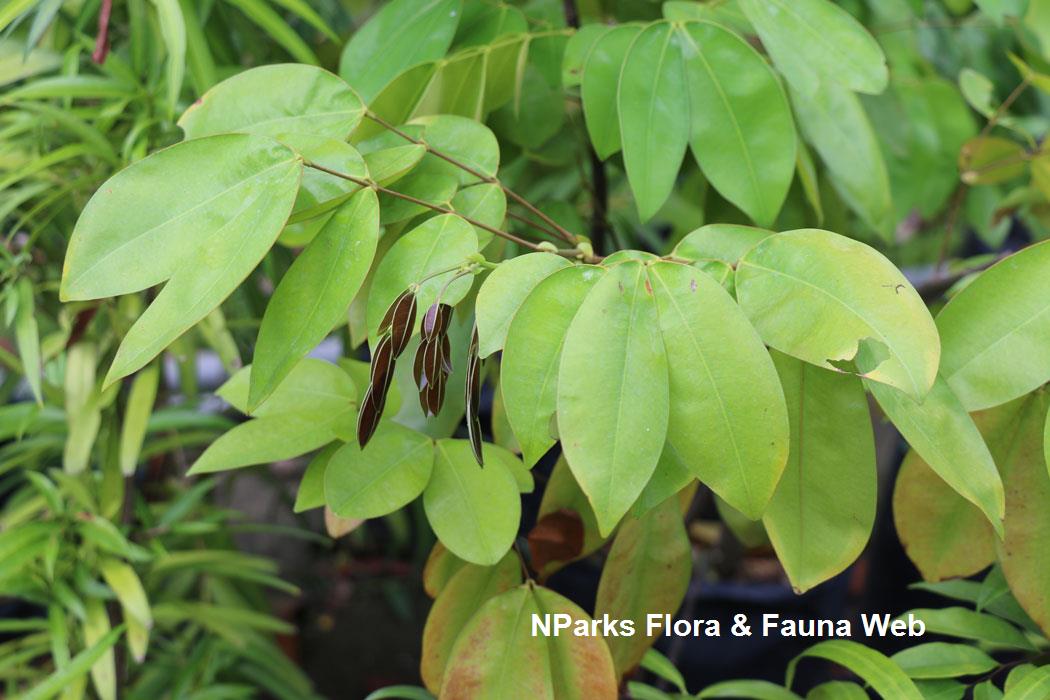.jpg)
Back
Sindora × changiensis L.M.Choo, Loo, W.F.Ang & K.Er
| Family Name: | Fabaceae (Leguminosae) |
Sindora × changiensis is a fertile hybrid between Sindora coriacea and Sindora echinocalyx. It is so far only known to occur naturally from Changi at the north-eastern coast of Singapore.
Name
Classifications and Characteristics
| Plant Division | Angiosperms (Flowering Seed Plants) |
|---|---|
| Plant Growth Form | Tree |
| Lifespan (in Singapore) | Perennial |
| Mode of Nutrition | Autotrophic |
| Plant Shape | Broad / Mushroom / Hemispherical |
| Maximum Height | 27 m |
| Tree or Palm – Trunk Diameter | 1.5 m |
Biogeography
| Native Distribution | Singapore |
|---|---|
| Native Habitat | Terrestrial |
| Preferred Climate Zone | Tropical |
| Local Conservation Status | Native hybrid |
Description and Ethnobotany
| Growth Form | It is a tree, up to 27 m tall, without buttress roots. The trunk can reach up to 1.5 m wide and have slightly raised rings around the girth. The bark is grey to black and slightly cracked or flaky. |
|---|---|
| Foliage | The leaves are compound, even-pinnate (paripinnate) and in alternate arrangement. Each leaf comprises of 6 – 8 leaflets. Leaflets are elliptic shaped (3.5 – 6.8 cm long and 2.3 – 3.5 cm wide), slightly curved and leathery texture. Upper surface is slightly glossy, while the lower surface is covered with a waxy bloom (glaucous) or densely covered with tiny short golden hairs (puberulous). The tip of the leaflet is acuminate to obtuse with a very slight notch (emarginate) while the base is rounded to obtuse. The midrib is flat or slightly sunken on the upper surface while raised on the underside. Two glands are present on leaflets. One of them occurs on the tip of the midrib on the underside while the other occurs on the thickened marginal vein close to the base. The stipule is semicircular (1.2 – 1.4 cm long) and falls off early. The leaf stalk (petiole) is 2 – 3 cm long. |
| Flowers | Occurring on the terminal and axillary part of the branches, the inflorescence is a branched cluster (panicle), about 11.5 – 25 cm long and 5 – 8 cm wide. Bracts and bracteoles fall off early. Each flower is surrounded by 4 unequal sepals where the outer surface of the sepals has small golden hairs while the inner surface is densely covered with long golden flattened hairs. Each flower has a petal nestled within the largest sepal, and ten stamens. These stamens occur in two bundles which are fused at the base. The longest filament is 12 – 15 mm long. Nine stamens bear pollens while the remaining one stamen on the other side of the flower is a sterile staminode. Ovary is almost diamond shaped and mostly covered with long dense hairs, except on the three strips where the hairs are less dense. |
| Fruit | The woody fruit pod is sparely spiny, flattened disc-shaped (7 – 8 cm long and 6 – 6.5 cm wide) with a beak. Armed with about 20 (or less) short spines on the outer surface, the fruit pod turns from green to brown and splits open when ripe. Each pod contains one seed which is attached to a yellowish-brown fleshy aril (2.2 – 2.6 cm long). The seed is black, smooth and about 2 – 2.5 cm long. |
| Habitat | It is found in tropical lowland forest. |
| Similar | Sindora × changiensis has characters which are both intermediate between the two parents and also a mix of characters from either parent. Fruit pod as well as the flowers are key to tell them apart. S. × changiensis has sparsely spiny fruit pods, smooth and unarmed calyx, and ovary which is densely hairy and without spines. On the other hand, S. coriacea has non-spiny fruit pods, smooth and unarmed calyx, and ovary which is mostly hairy with a glabrous patch in the centre. While S. echinocalyx has densely spiny fruit pods, spiny calyx, and ovary which is hairy with small blunt spines under the hairs. |
| Associated Fauna | It is observed to be pollinated by giant honeybee (Apis dorsata) |
| Taxonomy | Sindora × changiensis is a fertile and natural hybrid between Sindora coriacea and Sindora echinocalyx. |
| Cultivation | It can be propagated by seed. |
| Etymology | The genus Sindora comes from its native Sumatra vernacular name, Sindur. Latin changiensis, refers to Changi, Singapore, the place where it occurs naturally. |
| Ethnobotanical Uses | Cultural / Religious: Heritage Tree: There is currently one individual of Sindora × changiensis listed as Heritage Trees in Singapore. Carbon dating has estimated this tree to be at least 226 years old. To find out more about these trees, please visit the Heritage Tree Register. |
Landscaping Features
| Landscape Uses | Parks & Gardens |
|---|
Fauna, Pollination and Dispersal
| Fauna Pollination Dispersal Associated Fauna | Bee-Attracting |
|---|---|
| Pollination Method(s) | Biotic (Fauna) |
Plant Care and Propagation
| Light Preference | Full Sun |
|---|---|
| Water Preference | Moderate Water |
| Plant Growth Rate | Moderate |
| Rootzone Tolerance | Moist Soils, Well-Drained Soils |
Foliar
| Foliage Retention | Evergreen |
|---|---|
| Mature Foliage Colour(s) | Green |
| Mature Foliage Texture(s) | Leathery |
| Prominent Young Flush Colour(s) | Brown |
| Foliar Type | Compound (Even-Pinnate) |
| Foliar Arrangement Along Stem | Alternate |
| Foliar Attachment to Stem | Petiolate |
| Foliar Shape(s) | |
| Foliar Margin | Entire |
| Foliar Apex - Tip | Acuminate, Obtuse, Emarginate |
| Foliar Base | Rounded / Obtuse |
Non - Foliar and Storage
| Trunk Type (Non Palm) | Woody |
|---|---|
| Mature Bark Texture | Cracked, Peeling / Flaking / Papery |
| Root Type | Underground |
Floral (Angiosperm)
| Flower & Plant Sexuality | Bisexual Flowers |
| Flower Colour(s) | Cream / Off-White, Yellow / Golden |
|---|---|
| Flower Grouping | Cluster / Inflorescence |
| Flower Location | Terminal, Axillary |
| Flower Symmetry | Bilateral |
| Individual Flower Shape | Papilionaceous / Pea-shaped |
| Inflorescence Type | Panicle |
| Flowering Period | Once Yearly |
| Flowering Habit | Polycarpic |
Fruit, Seed and Spore
| Mature Fruit Colour(s) | Brown |
|---|---|
| Mature Fruit Texture(s) | Thorny / Spiny |
| Fruit Classification | Simple Fruit |
| Fruit Type | |
| Mature Seed Colour(s) | Black |
| Mature Seed Texture(s) | Smooth |
| Seed Quantity Per Fruit | Few (1-5) |
References
| References | Choo, L.M., Loo, A.H.B., Ang, W.F. and Er, K.B.H. (2022). A natural hybrid of Sindora (Fabaceae, Detarioideae) from Singapore. PhytoKeys 190: 87 – 102. |
|---|
Image Repository
Others
| Master ID | 34208 |
|---|---|
| Species ID | 8621 |
| Flora Disclaimer | The information in this website has been compiled from reliable sources, such as reference works on medicinal plants. It is not a substitute for medical advice or treatment and NParks does not purport to provide any medical advice. Readers should always consult his/her physician before using or consuming a plant for medicinal purposes. |

_lowres.jpg)

_lowres.jpg)
_lowres.jpg)

.jpg)
.jpg)
_lowres.jpg)
